Category A – Speed
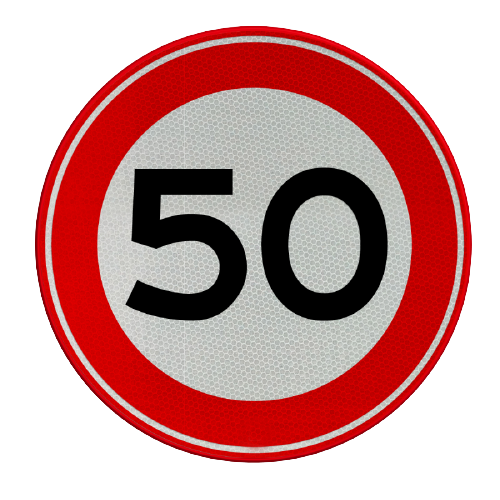
Sign A1 – Speed Limit
You are not allowed to drive faster than indicated on the sign here. In this case no faster than 50 kilometers per hour. You will often find this sign in places where it is not clear how fast you are allowed to drive or where the situation deviates from the standard speeds.
At road works within built-up areas, the sign is often placed with a maximum speed of 30 kilometers per hour. The speed on these signs then applies until the next side road. It often happens that people forget to remove these signs after the work has been completed. However, the lower speed limit will remain in effect. Incidentally, higher fines apply if you exceed the speed limit during road works. Whether there are actual road works is irrelevant to the increase of the fine. It is sufficient for the elevation if the sign J16, work in progress, is placed.
By a plate beneath the sign, the sign can be used for a certain category of vehicles, for example, trucks above a certain weight.
Once the speed limit is reduced, you should already reduce the speed as soon as you see the sign. Often drivers only reduce their speed after the traffic sign.
Watch out for overtaking oncoming traffic.
Keep more distance than usual if a lower speed limit applies. Drivers in front of you may brake suddenly. This is especially true for road works.
At intersections with traffic lights, a maximum speed of 70 kilometers per hour is indicated on motorways with this sign. The sign is often not placed at the beginning of the built-up area. It is sufficient to place the sign H1 (built-up area), because the maximum speed of 50 kilometers per hour already follows the general code of conduct regarding the speed limit within built-up areas.
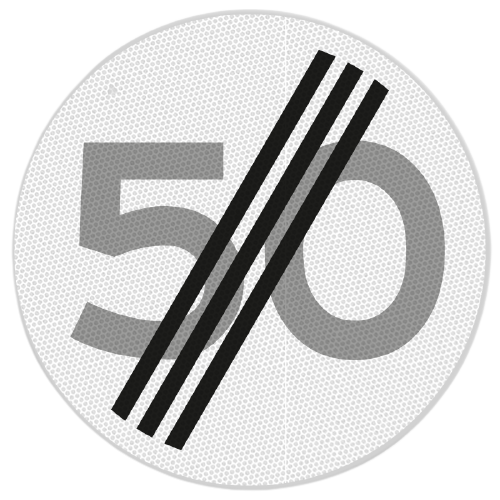
Sign A2 End of speed limit
This speed limit ends after this sign. Now the standard speeds apply again. Pay particular attention to other traffic that is known locally and that immediately wants to drive faster or overtake at or before this sign.
This sign is not applied when transitioning to another maximum speed. For example, when you enter an ERF or through an A1 sign with a different maximum speed, or at the end of a road section where the A1 sign is no longer valid.
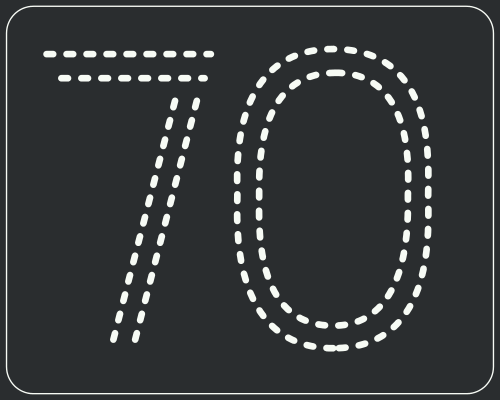
Sign A3 – Speed limit on an electronic sign
This sign has the same meaning as board A1 (maximum speed).
It is therefore not allowed to drive faster than indicated on the sign. In this case, therefore, no faster than 70 kilometers per hour.
This sign used to be an advisory speed and many older people still think it is.
So keep this in mind.
The lowest speed indicated on the electronic sign is 50 km/h.
When a lower speed is indicated for the first time, yellow warning lamps flash in the 4 corners of the sign.
Sign A3 only applies to the lane above which it is indicated. There may be a difference in maximum speed between different lanes.
This sign is not intended for permanent use, but only for temporary use.
It is used for traffic jams (danger), bridges, and tunnels.
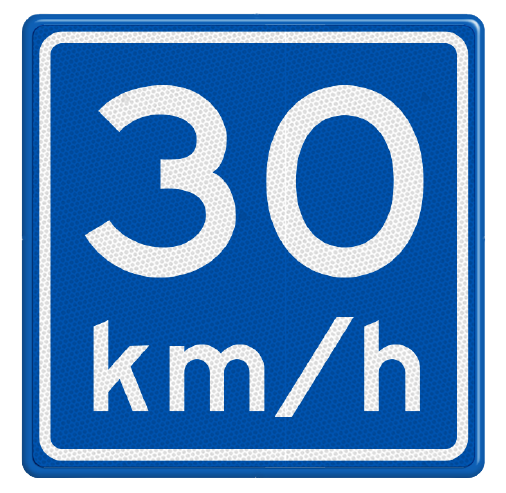
Sign A4 Recommended speed
This sign is placed where the government thinks it is wiser to drive a little slower. That is usually at dangerous bends and other dangerous situations.
Please note that this is an advisory speed, you may drive faster than is advised, but remember that these signs are there for a reason.
Now you may ask yourself why the government places these signs. If it is not considered safe to drive faster here, they can also just put up a sign with a maximum speed. They used to do that too, the government had rules and you just had to stick to them. Nowadays they want to place some of the responsibility on the drivers themselves.
Drivers who are well known locally often drive much faster than advised.
Truck and bus drivers often drive even slower than the recommended speed here.
There can be big differences in the speed driven by different drivers.
Also, keep a close eye on drivers behind you. Rushed, locally known drivers sometimes want to overtake.
This sign is only applied if the recommended speed is at least 20 kilometers per hour slower than the permitted maximum speed.
Application takes place if it is not clear and manageable from the driver’s point of view that it is better to reduce speed.
If possible, the sign is combined with a sign indicating the nature of the danger. This is not always possible, for example with negative road cant.
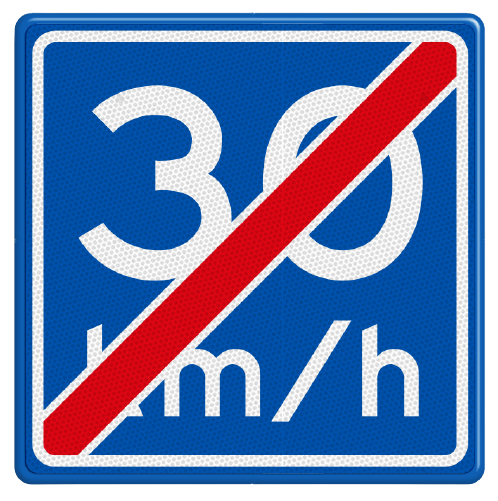
Sign A5 End of recommended speed
After this sign, it is considered safe to increase your speed to the normal speed limit.
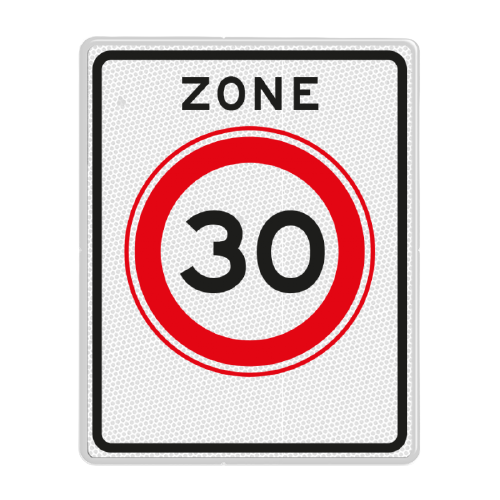
Sign zone 30
If you enter a 30 kilometer zone, you may not drive faster than 30 kilometers per hour in the entire zone. Until you have passed the sign with the end of 30 kilometers zone, you may not drive faster than thirty kilometers per hour.
There are no deviating priority and parking rules in such a zone. In such a zone, speed-reducing measures are often taken, such as speed bumps, flower boxes, staggered road sections, and other obstacles. 30 km zones are often created for these types of areas to prevent cut-through traffic. You can encounter 30 kilometer zones both inside and outside built-up areas.
In a 30 kilometer zone you have to take into account, among other things:
- Playing kids.
- Children suddenly appearing on the roadway.
- School-age youth. They can move on foot, by bicycle, moped and light moped.
- Be extra attentive during school start and end times.
- Take into account mothers, and off course fathers also 😊, who bring and collect their children by car.
- All kinds of age categories, from young to elderly.
- Parking and moving vehicles out of the parking position.
- Suddenly opening doors. Supply vehicles and their drivers.
- Shopping public.
The basic principle is that all roads within a 30 kilometer zone are equal. Controlling the priority is only possible to a limited extent. It is allowed at intersections with:
- Solitary bus lanes.
- Solitary cycle paths and solitary cycle/moped paths.
- Main bicycle routes that are clearly recognizable and on which only limited motorized traffic is allowed.
In the decision to regulate the priority, extra attention must be paid to speed limits and/or attention increases.
For example, the construction of “zebra crossings” is also limited. These may, for example, be constructed if schools or nursing homes are nearby. Crosswalks are then often constructed on an elevation.

Sign End zone 30
After this sign, you may again drive at the locally applicable speed limit.
If you leave a zone 30, you do not always have to give way to drivers on the intersecting road.
Do you have to do this if there are traffic signs or has an entrance and exit construction been installed.
The transitions to a different maximum speed are sometimes clearly recognizable due to the construction.
Often, however, no clear difference between the road and the environment is noticeable. It is not always the case that the end of a 30 kilometer zone is equal to an intersection. If this is the case, then the priority is regulated by means of traffic signs or an entrance and exit construction, unless the intersecting road is suitable to be included in the area concerned.
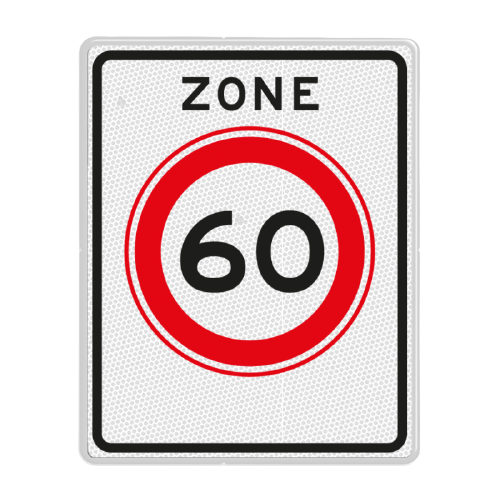
Sign Zone 60
On roads outside built-up areas, a speed limit of 80 kilometers per hour applies.
This speed is often still too high, because pedestrians and cyclists also come on these roads. It is then decided to change these roads into 60 kilometer zones. A maximum speed of 60 kilometers per hour applies in these zones. This speed limit applies until you pass the sign at the end of the 60 km/h zone.
In general, you are driving on a single carriageway in such a zone.
Thresholds are often constructed so that you can also drive over 60 kilometers per hour. The roads are made visually narrower through the construction of bicycle or suggestion lanes.
Various studies have shown that fewer accidents occur in these zones.
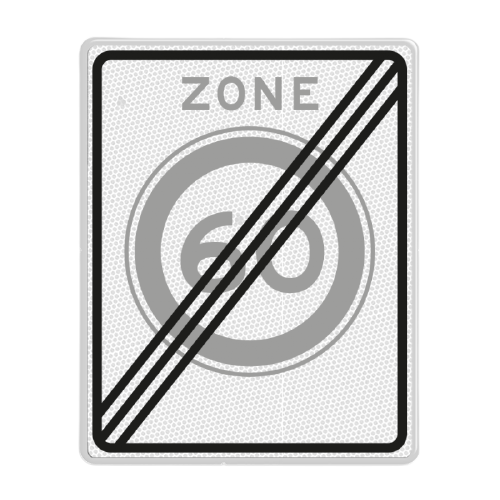
Sign End zone 60
This is where the 60 kilometer zone ends.
After this sign, you are allowed to drive 80 again.
